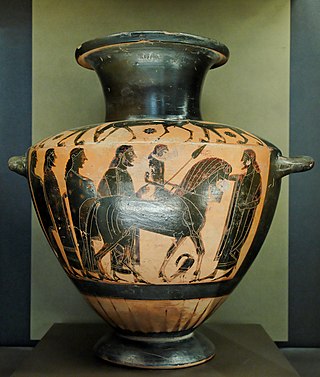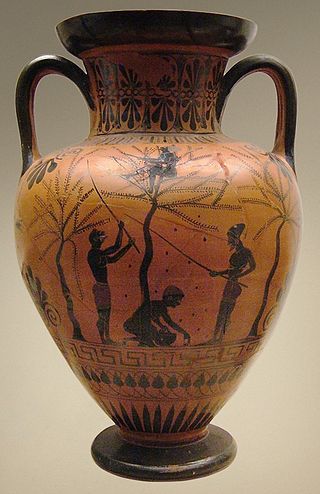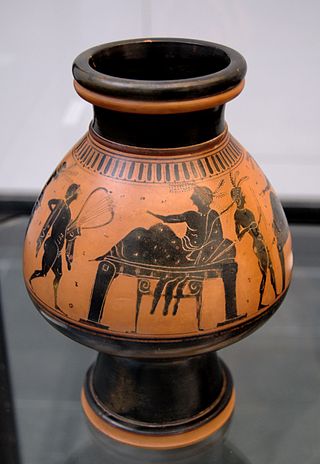Gallery
- Herakles fighting the Lernaean Hydra, circa 540/530 BC. Paris: Louvre
The Princeton Painter was an Attic black-figure vase painter, active in the third quarter of the sixth century BC, just after Group E. His real name is not known.
He is a typical representative of the Attic vase painting of his time. He mainly painted neck amphorae and belly amphorae of the types then current. His motifs also conform to the patterns popular at the time, with few variations. He was aware of the artistic developments of his period, but only able to incorporate them into his works to a limited extent. In artistic terms, he is no comparison to his dominant contemporary, Exekias. The vases by him and other artists demonstrate that there was still scope for development in the black-figure style.

Black-figure pottery painting, also known as the black-figure style or black-figure ceramic, is one of the styles of painting on antique Greek vases. It was especially common between the 7th and 5th centuries BCE, although there are specimens dating in the 2nd century BCE. Stylistically it can be distinguished from the preceding orientalizing period and the subsequent red-figure pottery style.

Exekias was an ancient Greek vase painter and potter who was active in Athens between roughly 545 BC and 530 BC. Exekias worked mainly in the black-figure technique, which involved the painting of scenes using a clay slip that fired to black, with details created through incision. Exekias is regarded by art historians as an artistic visionary whose masterful use of incision and psychologically sensitive compositions mark him as one of the greatest of all Attic vase painters. The Andokides painter and the Lysippides Painter are thought to have been students of Exekias.

Sophilos was an Attic potter and vase painter in the black-figure style. Sophilos is the oldest Attic vase painter so far to be known by his true name. Fragments of two wine basins (dinoi) in Athens are signed by him, indicating that he both potted and painted them. In total, 37 vessels are ascribed to him, mostly amphorae, dinoi, kraters, as well as three pinakes. Apart from his work for the domestic market, he was also one of the masters of major significance in the process of supplanting the dominance of Corinthian vase painting in the markets of Etruria, and Southern Italy, the most important export area for Greek vases. His works were exported as far as the Black Sea region, Syria and Egypt (Naukratis).

The Kleophrades Painter is the name given to the anonymous red-figure Athenian vase painter, who was active from approximately 510–470 BC and whose work, considered amongst the finest of the red-figure style, is identified by its stylistic traits.

Nikosthenes was a potter of Greek black- and red-figure pottery in the time window 550–510 BC. He signed as the potter on over 120 black-figure vases, but only nine red-figure. Most of his vases were painted by someone else, called Painter N. Beazley considers the painting "slovenly and dissolute;" that is, not of high quality. In addition, he is thought to have worked with the painters Anakles, Oltos, Lydos and Epiktetos. Six's technique is believed to have been invented in Nikosthenes' workshop, possibly by Nikosthenes himself, around 530 BC. He is considered transitional between black-figure and red-figure pottery.

Lydos was an Attic vase painter in the black-figure style. Active between about 560 and 540 BC, he was the main representative of the "Lydos Group". His signature, ό Λυδός, ho Lydos, inscribed on two vases, is informative regarding the cultural background of the artist. Either he immigrated to Athens from the Lydian Empire of King Kroisos, or he was born in Athens as the son of Lydian parents. In any case, he learned his trade in Athens.

The Affecter was an Attic black-figure vase painter, active in Athens around 550 to 530 BCE.

The Antimenes Painter was an Attic vase painter of the black-figure style, active between circa 530 and 510 BC.

Psiax was an Attic vase painter of the transitional period between the black-figure and red-figure styles. His works date to circa 525 to 505 BC and comprise about 60 surviving vases, two of which bear his signature. Initially he was allocated the name "Menon Painter" by John Beazley. Only later was it realised that the artist was identical with the painters signing as "Psiax".

Andokides was an ancient Athenian vase painter, active from approximately 530 to 515 BC. His work is unsigned and his true name unknown. He was identified as a unique artistic personality through stylistic traits found in common among several paintings. This corpus was then attributed by John D. Beazley to the Andokides Painter, a name derived from the potter Andokides, whose signature appears on several of the vases bearing the painter's work. He is often credited with being the originator of the red-figure vase painting technique. To be sure, he is certainly one of the earliest painters to work in the style. In total, fourteen amphorae and two cups are attributed to his hand. Six of the amphorae are "bilingual", meaning they display both red-figure and black-figure scenes.

The Polos Painter was a vase painter of the Attic black-figure style. His works date to c. 575 to 565 BC.

Little-Master cups are a type of Attic black-figure cups, produced around the middle and third quarter of the sixth century BC. Their name is based on their fine small-format decoration. Little-Master cups are later in origin than Siana cups, but both types were produced over a considerable period of time. The Little Masters painted only the small upper frieze above the carination of the cup, at times also the lip or handle areas. It is probably that only few of the painters of Siana cups also painted Little-Master cups. One of the first artists to introduce the Little-Master cup in Athens was Kleitias. The change in decoration went along with a lengthening of the cup foot. The dedicated painters of Little-Master cups rarely painted larger formas, whereas painters primarily specialised in large vases are known to also have painted Little-Master cups. Stylistic comparison between larger and smaller formats of the period remains difficult.

Group E was a group of Attic vase painters of the black-figure style. They were active between 560 and 540 BC.

Pamphaios was an Attic potter active around the end of the 6th century BC. Pamphaios was the successor of Nikosthenes in that artist's workshop, and thus took over from one of the most influential and creative potters of antiquity. He probably took over the workshop before 510 BC and continued the tradition of his predecessor by producing typical shapes the latter had developed, such as the Nikosthenic amphora, the Nikosthenic pyxis or the Chalkidian style cup. At times, he developed these shapes further. Unlike Nikostehenes, Pamphaios favoured painters of the red-figure style, which was at the time replacing the previously dominant technique of black-figure vase painting. He also continued to employ many of the painters that had worked for Nikosthenes, such as Oltos, Epiktetos and the Nikosthenes Painter.
Elbows Out is the name given to an Attic black-figure vase painter, active in Athens around 550/540 to 520 BC. His conventional name is derived from the strongly exaggerated gestures and odd anatomy of his dancing figures. Together with the Affecter, he is considered one of the Mannerists of the black-figure style. He painted e.g. lip cups and neck amphorae, the latter in a special shape with a heavy ovoid body. His amphorae are decorated with several friezes. His band cups resemble works by Tleson and Lydos, but are more conventional in terms of the animal motifs. He also painted a lydion, a vase shape very rarely produced by Attic potters. He is often seen as connected with the Affecter, but also with the Amasis Painter. The link with the latter should not be overestimated.

The Leagros Group was a group of Attic black-figure vase painters active during the last two decades of the 6th century BC. The name given to the group by modern scholars is a conventional one, derived from a series of name vases.

The Swing Painter was an Attic black-figure vase painter, active in the third quarter of the sixth century BC. His real name is unknown.

The Rycroft Painter was an Attic late black-figure vase painter, active in the final decade of the sixth century BC. His real name is not known.

The Euphiletos Painter was an Attic black-figure vase painter active in the second half of the sixth century BC.

The Lysippides Painter was an Attic vase painter in the black-figure style. He was active around 530 to 510 BC. His conventional name comes from a kalos inscription on a vase in the British Museum attributed to him; his real name is not known.